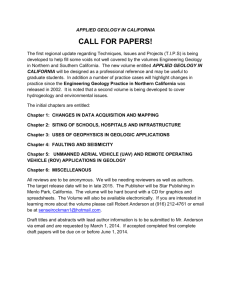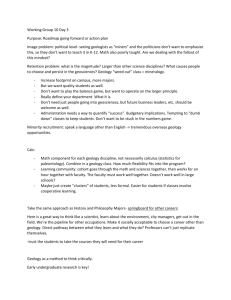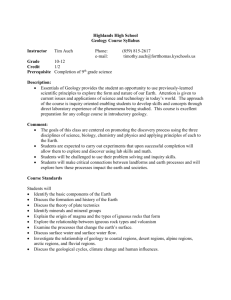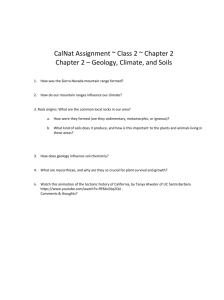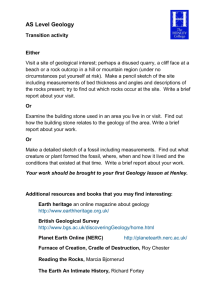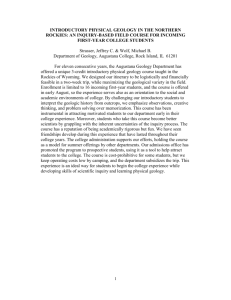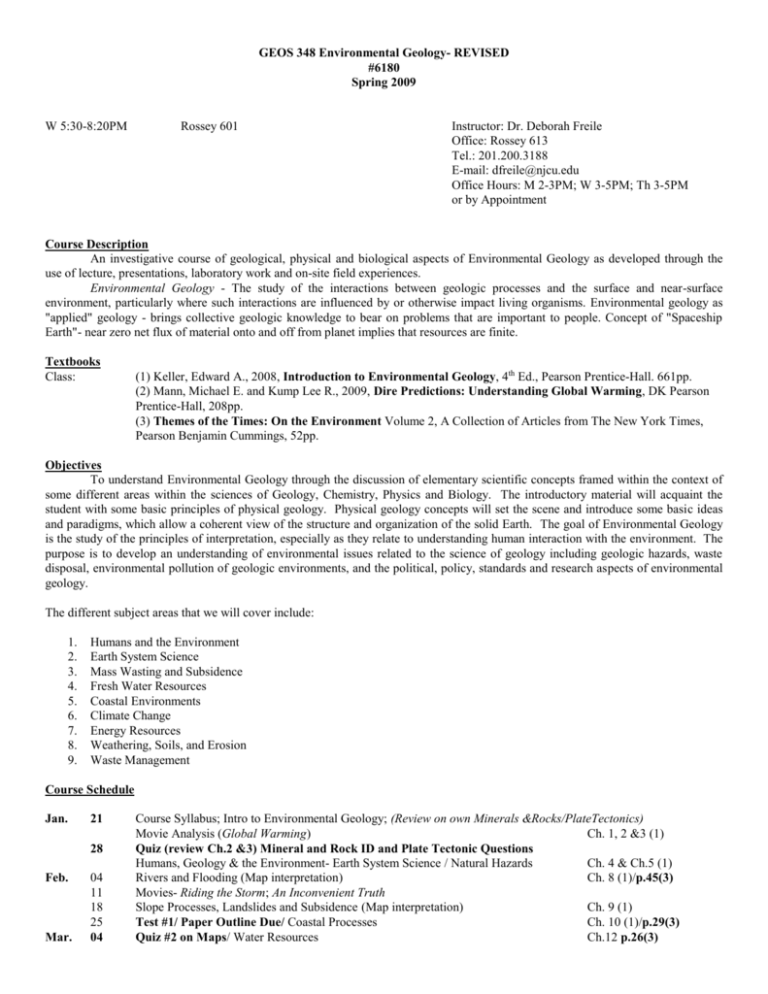
GEOS 348 Environmental Geology- REVISED
#6180
Spring 2009
W 5:30-8:20PM
Rossey 601
Instructor: Dr. Deborah Freile
Office: Rossey 613
Tel.: 201.200.3188
E-mail: dfreile@njcu.edu
Office Hours: M 2-3PM; W 3-5PM; Th 3-5PM
or by Appointment
Course Description
An investigative course of geological, physical and biological aspects of Environmental Geology as developed through the
use of lecture, presentations, laboratory work and on-site field experiences.
Environmental Geology - The study of the interactions between geologic processes and the surface and near-surface
environment, particularly where such interactions are influenced by or otherwise impact living organisms. Environmental geology as
"applied" geology - brings collective geologic knowledge to bear on problems that are important to people. Concept of "Spaceship
Earth"- near zero net flux of material onto and off from planet implies that resources are finite.
Textbooks
Class:
(1) Keller, Edward A., 2008, Introduction to Environmental Geology, 4th Ed., Pearson Prentice-Hall. 661pp.
(2) Mann, Michael E. and Kump Lee R., 2009, Dire Predictions: Understanding Global Warming, DK Pearson
Prentice-Hall, 208pp.
(3) Themes of the Times: On the Environment Volume 2, A Collection of Articles from The New York Times,
Pearson Benjamin Cummings, 52pp.
Objectives
To understand Environmental Geology through the discussion of elementary scientific concepts framed within the context of
some different areas within the sciences of Geology, Chemistry, Physics and Biology. The introductory material will acquaint the
student with some basic principles of physical geology. Physical geology concepts will set the scene and introduce some basic ideas
and paradigms, which allow a coherent view of the structure and organization of the solid Earth. The goal of Environmental Geology
is the study of the principles of interpretation, especially as they relate to understanding human interaction with the environment. The
purpose is to develop an understanding of environmental issues related to the science of geology including geologic hazards, waste
disposal, environmental pollution of geologic environments, and the political, policy, standards and research aspects of environmental
geology.
The different subject areas that we will cover include:
1.
2.
3.
4.
5.
6.
7.
8.
9.
Humans and the Environment
Earth System Science
Mass Wasting and Subsidence
Fresh Water Resources
Coastal Environments
Climate Change
Energy Resources
Weathering, Soils, and Erosion
Waste Management
Course Schedule
Jan.
21
28
Feb.
Mar.
04
11
18
25
04
Course Syllabus; Intro to Environmental Geology; (Review on own Minerals &Rocks/PlateTectonics)
Movie Analysis (Global Warming)
Ch. 1, 2 &3 (1)
Quiz (review Ch.2 &3) Mineral and Rock ID and Plate Tectonic Questions
Humans, Geology & the Environment- Earth System Science / Natural Hazards
Ch. 4 & Ch.5 (1)
Rivers and Flooding (Map interpretation)
Ch. 8 (1)/p.45(3)
Movies- Riding the Storm; An Inconvenient Truth
Slope Processes, Landslides and Subsidence (Map interpretation)
Ch. 9 (1)
Test #1/ Paper Outline Due/ Coastal Processes
Ch. 10 (1)/p.29(3)
Quiz #2 on Maps/ Water Resources
Ch.12 p.26(3)
Apr.
May.
09-14
18
25
01
08
15
22
29
06
Spring Break, No Class
Water Pollution/ 1st Draft Paper Due/ Mineral Resources
Mineral Resources/ Energy Resources
Energy Resources
Test #2/ Paper Due/ Soils and the Environment
Soils and the Environment / Waste Management
Waste Management/ Climate Change
Group & Individual Presentations
Final Exam 6:00- 8:00 PM
Ch. 13 & Ch. 14/ p.36(3)
Ch. 14 & Ch. 15/p.16(3)
Ch. 15/ p.19(3)
Ch. 16
Ch. 17
Ch. 17 & 19
COURSE REQUIREMENTS
Attendance: Attendance is strongly recommended. Attendance will be taken at the start of each class period. Excused absences
from class will be granted only upon a written medical or sponsored university activity notification. If the student comes to class late,
it is his or her responsibility to inform the instructor and sign the attendance sheet. Once the instructor leaves the classroom, any
student not appearing on the attendance sheet will be counted as absent.
Methods of Instruction: This course will employ the following pedagogic techniques;
1. Lecture and lab discussion of material.
2. Audio visual instruction in the form of PowerPoint presentations and/or specific VHS tapes or DVDs
3. Laboratory lecture and applied problem solving skills and analysis.
4. Testing
5. Guest Speakers
6. There will be an instructor’s webpage with PowerPoint slides
Evaluation Components and Grading Scale
Tests (2 @ 15%)
Quizzes
Field Trip s
Final exam
Paper on Global Warming
HW/Laboratory/ Written Assignments
Group Project/Presentation
30%
10%
10%
15%
10%
15%
10%
100%
Quizzes and Tests: There will be 2 practical quizzes given as well as a maybe couple others. All tests will consist of the following
types of questions- definitions, short answer, and diagrams to label and construct problems to solve. All tests will contain an extracredit question for bonus points. Make-up tests will not be given under any circumstance. The final, which is mandatory, will be
comprehensive and account for 15% of the grade.
Field Trip: You will be required to attend two field trips. One, probably a 2-day field trip in late March or early April (TBA), -. The
other one (to a landfill- Probably the old Staten Island) in April probably on the 18th. I will let you know FOR certain in a couple of
weeks.
Paper on Global Warming: You are expected to write a 5-6 page paper with additional graphs, figures and references on global
warming. The main book for you to use will be Dire Predictions (2) by Mann and Kump. But you will also be exposed throughout
the semester to several films and if you choose to go to the AMNH exhibit on Climate Change. This paper has to be written consistent
with scientific format and you have to use at least 5 refereed publications. I will not tolerate plagiarism of any sort.
Grading
Outline due
due Feb 25th
First Draft due due Mar. 18th
Final
due Apr 8th
Grading: Content
35 pts
Completeness
20pts
Paper must be divided into sections with headings and subheadings {Abstract, Introduction,
Body, Summary and Conclusions; Appendices}
Figures
15 pts
Bibliography*
15 pts
Spelling/grammar 15 pts
* Proper formatting must be followed; see below
This paper has to be written in a scientific manner. References should be cited within the paragraphs for an idea that is not yours [i.e.
According to Smith (1995) the concentration of sulfur in............. or The concentration of sulfur was determine to be ........ (Smith,
1995)]. Several figures (charts, graphs, maps, etc.) must be included in your paper to illustrate your points. Do NOT take paragraphs
out of books or articles ‘as is’, always paraphrase or summarize the information and reference it. I do not want to see a string of quotes
from other writers linked together with ‘and’, ‘while’, ‘however’, and other such conjunctions. Do not use footnotes. They are not
used in the sciences.. At the end of the paper provide a bibliography of all material used and cited. The following format should be
used when writing this bibliography:
In case of an article in a journal:
Author last name, First name, date. Title of article (small letters; except for proper nouns), Journal(italicized) vol., number, pages.
[i.e.: Smith, John, J., 1995, Sulfur determinations in natural waters, Journal of Hydrology, vol. 32, no. 4, p. 34-56.]
In case of a book:
Author last name, First name, date. Title of Book, Edition, Publisher, City, Total pages.
[i.e.: Smith, John, J., 1995, Geochemistry of Natural Waters, Second Edition, Mark University Press, Harmony, MN, 295 pp.]
Homework/Laboratory/Written Assignments: The ‘laboratory’ component of this course will discuss and apply basic concepts of
environmental geology. Specific topics will include a brief introduction to maps topographic as well as geologic maps. The students
will apply the concepts learned by fulfilling lab HW assignments. Written assignments will include analyses of Newspaper reports
from the Themes of the Times (3) that you need to read and answer questions about in a short (1-page) answer format and turn in
according to the schedule, also films or other media summaries.
Project/Presentation: A Phase I Environmental Site Assessment is a report prepared for a real estate holding which identifies
specific environmental contamination liabilities. The analysis, often called a Phase I ESA, typically addresses both the underlying land
as well as physical improvements to the property; however, techniques applied in a Phase I ESA never include actual collection of
physical samples or chemical analyses of any kind. Scrutiny of the land includes examination of potential soil contamination,
groundwater quality, surface water quality and sometimes issues related to toxic uptake by biota. The examination of a site may
include: definition of any chemical residues within structures; identification of possible asbestos containing building materials;
inventory of toxic substances stored or used on site; assessment of mold and mildew; and evaluation of other indoor air quality
parameters. You will conduct a mock ESA Phase I on several plots of land in Jersey City that are or were considered part of a
Brownfield in the Historic section of downtown Jersey City. You and your team members will collect all pertinent information, write a
report and present the information to the class for your parcel. The group paper is due April 29th along with your presentation
PHASE ONE ENVIRONMENTAL SITE ASSESSMENT REQUIREMENTS:
1. Physical inspection of the entire subject property.
2. Interviews with persons knowledgeable of the property.
3. Review of state and federal lists of known contaminated sites, hazardous materials users, spills, toxic contaminants (presence
of above ground or underground storage tanks, storage of acids, etc.)
4. Evaluation of nearby operations for their potential to affect subject property.
5. Interpretation of topographic maps and aerial photographs.
6. Review of any existing environmental documents for the project area. (State water board, fire department, county health
department, etc)
7. Current and past use of the property.
8. Review of recorded owner history at applicable register of deeds office.
9. Conclusions and recommendations.
Some Useful Sites for you to consider for the projectASTM site information
http://www.astm.org/cgi-bin/SoftCart.exe/DATABASE.CART/REDLINE_PAGES/E1527.htm?E+mystore
http://www.astm.org/cgibin/SoftCart.exe/DATABASE.CART/REDLINE_PAGES/E1528.htm?L+mystore+hhgg9629+1169525529
http://www.astm.org/cgibin/SoftCart.exe/DATABASE.CART/REDLINE_PAGES/E1527.htm?L+mystore+hhgg9629+1169497250
EPA site info PDF files of importance
http://www.epa.gov/brownfields/pdf/sustain.pdf
http://www.epa.gov/fedfac/pdf/cfatf_guide_liability.pdf Chapter 4
http://clu-in.org/download/misc/roadmap3edition.pdf
http://www.epa.gov/brownfields/pdf/susmodel.pdf
http://www.epa.gov/reg3hwmd/bfs/grants/2004excerpts.htm
New Jersey Department of Environmental Protection
http://www.state.nj.us/dep/srp/isra/s1070.htm
http://www.nj.gov/dep/srp/regs/isra/
http://www.state.nj.us/dep/srp/isra/forms/pa_form.pdf
http://www.state.nj.us/dep/srp/publications/brownfields/2001/11_process.htm
http://www.state.nj.us/dep/srp/brownfields/
Grading Scale
95-100 A
90-94 A-
87-89
84-86
B+
B
80-83
77-79
BC+
74-76
68-73
C
C-
58-67
D
Expected Outcomes: After completing this course the student is expected to have a solid understanding of the history and evolution of
the environmental geology and the interactions between humans and the environment. The student will be able to explain the internal
and external processes that have shaped the current environmental problems facing the earth today. The student will also have
developed skills in analyzing maps, reports and solving problems faced by environmental professionals and the observation and
analysis of the same in practical situations such as a field trip. The students will have made a useful contribution to the success of their
understanding of science and scientific principles and their application to the world around them. For us, the challenge is to understand
the important physical processes in geology, their impacts on humans, and ways in which humans can mitigate natural hazards. To
discuss resource issues that will dominate the political and social arena during our lifetimes, and to discuss the positive role that
individuals and institutions such as the government can play in issues regarding resource conservation and hazard mitigation.
Participation: Class participation is an important part of the learning process. Participation in class is highly encouraged and
variations in points of view are welcomed.
Assignments: Students must submit all major assignments on time in order to take the final examinations. Failure to do so will result
in failure of the course.
Academic Dishonesty: Students are expected to demonstrate academic integrity at all times. NJCU condemns cheating and
plagiarism in any form; intentionally using the ideas, knowledge, words, and/or visual images of another individual as if those were
original to the writer or speaker; and any other forms of deceit in relation to the student’s affiliation with and commitment to the
university. In this course any student caught cheating on any test or plagiarizing any work will receive an ‘F’ for the entire course.
Extra Credit: There will be one extra credit opportunity. The extra credit will earn up to 15 points added to the final exam and will
consist of going to the American Museum of Natural History and answering questions on their exhibit on Climate Change. I will post
information of this on the website in the near future.
Withdrawal: Please note that April 15th is the last day to withdraw from a course with a grade of “W”.
Cell Phones and Pagers: Please turn OFF all cell phones and pagers. If a phone rings during class time the student will be asked to
leave and counted as absent for that day.

